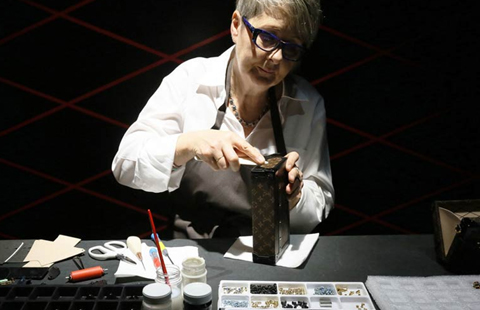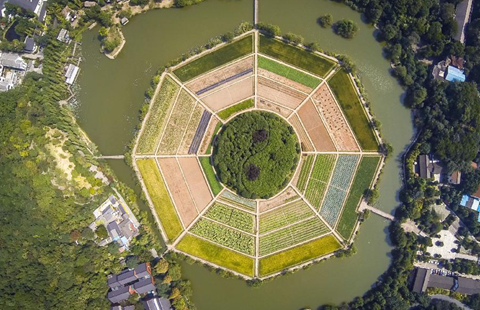Ancient way of divorce captivates Web users
Updated: 2015-04-09 07:40
By Xu Jingxi(China Daily USA)
|
||||||||
Tang Dynasty agreements show that couples went their separate ways in amicable manner
Excerpts from ancient divorce agreements that have gone viral on social media show that a surprisingly open attitude toward divorce existed in feudal China more than 1,000 years ago.
"Now that the affinity between us has faded away, let's merry meet, merry part, with our families as the witness to our divorce," one of the agreements reads.
"I hope that you will doll yourself up afterward and marry a good man."

Twelve "romantic" divorce agreements were unearthed at the Dunhuang Mogao Grottoes in Gansu province in 1900, and historians believe they date from the Tang Dynasty (AD618-907).
A collection of photocopies of documents found in Dunhuang, published by the China National Microfilming Center for Library Resources, includes seven of the agreements. Five are labeled as a format for letters sent by husbands to their wives.
The gracefully worded letters start by cherishing the "god-given fate" that led the couple to become man and wife, then talk in reasonable terms about the conflicts that arose between them. Most end with the husband's expressions of best wishes for the wife's happy remarriage.
Excerpts from the agreements have now found their way online.
"The status of women in ancient China was not as low as people today may think," Yu Chenglong, a researcher at the National Museum of China, told China Daily.
"Ancient people held freedom in relationships in high esteem, and remarriage was not unusual until the Song Dynasty (AD 960-1279) when Chengzhu Lixue, a philosophical school of neo-Confucianism that imposed many restrictions on women such as not remarrying after their husband's death, rose to become the dominant philosophy."
The country's divorce rate is increasing, as is shown in the most recent figures released by the Ministry of Civil Affairs. In 2013, 3.5 million couples divorced, a year-on-year increase of 12.8 percent. The rate rose for 10 consecutive years from 2004.
Ge Chengyong, editor-in-chief of Cultural Relics Press, a publication produced by the State Administration of Cultural Heritage, said the fact that the ancient divorce agreements have caught the public's imagination may be related to the pressure put on couples who decide to divorce today.

"It is complicated and difficult to get divorced in today's society, with arguments over many issues such as the sharing out of property," Ge told China Daily.
"So it's natural that people long for the seemingly simple and friendly divorces of the old days, as shown in the unearthed documents."
Ge said he hopes the Tang Dynasty agreements will not just be a passing topic on the Internet, but will encourage the public to develop a deeper interest in history.
Yu added: "People in China are taking a greater interest in archaeology. The Tang Dynasty divorce agreements have become a popular conversation piece because people have a thirst for knowledge about historical relics and the past."
The 12 divorce agreements are kept in museums in the UK, France and Russia. Some were displayed in the National Museum of China in 2000 and attracted a considerable amount of attention, according to Beijing Sci-Tech Report.
xujingxi@chinadaily.com.cn
(China Daily USA 04/09/2015 page5)

 Last batch of Chinese peacekeeping infantry arrives in S.Sudan
Last batch of Chinese peacekeeping infantry arrives in S.Sudan
 With high property prices, is it OK to rent forever?
With high property prices, is it OK to rent forever?
 Top 7 glass producers in China
Top 7 glass producers in China
 China, Vietnam work to build ties
China, Vietnam work to build ties
 Louis Vuitton Series 2: Past, Present, and Future
Louis Vuitton Series 2: Past, Present, and Future
 Buddhist ritual held on Jiuhua Mountain in E China's Anhui
Buddhist ritual held on Jiuhua Mountain in E China's Anhui
 Photographer focuses lens on China's rail history
Photographer focuses lens on China's rail history
 Phone booths are given Baymax makeover
Phone booths are given Baymax makeover
Most Viewed
Editor's Picks

|

|

|

|

|

|
Today's Top News
Boston bomber convicted, may face death penalty
US mulls major arms sales to Egypt
Zhou trial likely to serve as model
Energy security, goodwill top Obama agenda in Jamaica visit
Chinese insurers invest in Boston Seaport site
Chinese billionaire buys vase for $14.7 million
Survey: China bests Japan on economic ties
World Bank welcomes AIIB
US Weekly

|

|





